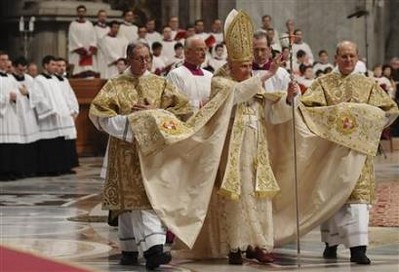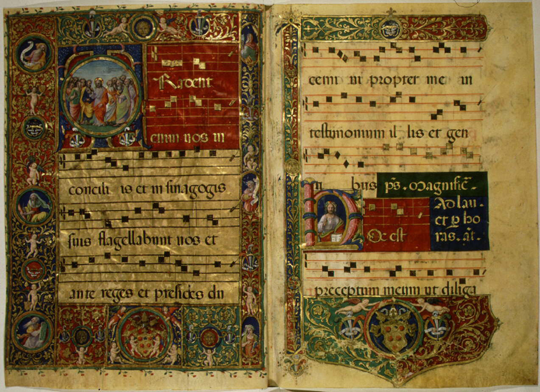 |
| Msgr. Guido Marini celebrates Mass ad orientem at Santa Maria Maggiore. (Photo from the New Liturgical Movement) |
On Fr. Z's excellent blog, What Does the Prayer Really Say, is an article from the Washington Post. The article features an interview with Msgr. Guido Marini, the Papal Master of Ceremonies. It is an excellent piece because Msgr. Marini offers some valuable insight into the importance liturgical appropriateness.
According to Marini, the criterion for the papal liturgies is beauty. This is something that the Holy See has been promoting every since April 19, 2005, when the former Joseph Cardinal Ratzinger was elected to the Chair of St. Peter. That is also something that the former Cardinal long promoted way before he became Pope Benedict XVI.
According to the article:
Since the Marini II era began in October 2007, the papal Masses clearly have a stronger traditional element. Guido Marini, who has degrees in canon and civil law and a doctorate in the psychology of communication, caused considerable consternation among some progressive Catholics in January when he talked to English-speaking priests about a "reform of the reform."
In an interview Thursday, he argued that the changes should not be seen as a liturgical backlash to modernity but as a "harmonious development" in a "continuum" that takes full advantage of the church's rich history and is not subject to what he has called "sporadic modifications." Liturgical progressives, like Bishop Donald Trautman of Erie, Pa., are concerned that Marini considers the reforms of the 1960s ecumenical council known as Vatican II as being among those sporadic modifications.
At most papal Masses, a large crucifix flanked by tall candles is now displayed on the altar, even though many progressives say the ornaments block the view of the priest and the bread and wine. They argue that this obstructs the accessibility urged by liturgical reforms associated with the Second Vatican Council.
Marini responds by saying that the crucifix reminds the faithful of who is really front and center in the Mass. He also says that the pope cannot sit in front of the altar when it bears the crucifix because "the pope can't give his back" to sacraments on the altar.
For Marini, Gregorian chants must be the music of the church because they best interpret the liturgy. And in September, ahead of the pope's visit to Britain, Marini told the Scottish paper the Herald that the pope would celebrate all the Prefaces and Canons of his Masses in Latin.
He added that Benedict considered the Mass a heavenly space that shouldn't be modified with "things that don't belong."
Marini has said there are no plans to force the changes on parishes around the world, but he hopes that they slowly spread and seep in.
Under Benedict, the faithful at papal Masses take Communion on their knees and receive the wafer on the tongue. Guido Marini said the change "recalls the importance of the moment" and keeps the act from becoming "banal."
There seems to be a lot of misinterpretation and misunderstanding of what the Second Vatican Council actually called for in its reforms. Latin and Gregorian Chant were never abolished. In fact, it was assumed that Latin would still be used and that the Mass would not necessarily be celebrated in the vernacular completely. In fact, the Constitution on Sacred Liturgy specifically states that Latin is to be retained. Pope Benedict also made that same call in his first Apostolic Exhortation, Sacramentum Caritatis, especially in Masses where more than one vernacular language is used. It never ceases to amaze me when both OCP and WLP trout out their tawdry bilingual Mass settings. Sadly, these tend to take liberties with the text and also feature very bad, almost banal music. Simple Latin chants, which were called for by Pope Paul VI when he commissioned Jubilate Deo, would effectively solve the problem because, naturally, they are the official prayers of the Church and their musical settings are genuinely sacred.
Ad orientem was also never deleted from the Holy Sacrifice. In fact, careful reading of the rubrics actually assumes that the priest is using this posture during certain parts of the Mass. It is not important to see the priest; rather, it is important to have that encounter with Christ. The priest is leading us forward to that encounter. Together, we are seeking the face of God. It is a point that both the Holy Father and Fr. Uwe Michael Lang, who is a consultor to both the Congregation for Divine Worship and the Office of Liturgies for the Supreme Pontiff, have made in their respective books. In fact, the Holy Father will more than likely assume the ad orientem posture when he celebrates the Holy Sacrifice at the Sistene Chapel to mark the Solemnity of the Baptism of the Lord.
Msgr. Marini has been a godsend to the Papal liturgies. When he came onboard, it was as though the Papal liturgies started to make a 180-degree turn towards what is proper. It also helps the Holy Father when he and his Papal Master of Ceremonies are on the same page. Pope Benedict XVI and Msgr. Marini work in tandem together. This is very important.
Although Msgr. Marini does not mandate that the changes he has brought forth at the behest of the Holy Father be copied exactly in our local parishes, these Masses should serve as the example par excellence as to how an authentic Ars Celebrandi can be achieved. One does not necessarily have to have the grandiose space of St. Peter's Basilica or the ornate vestments and sacred vessels in order to have beauty. Beauty in the liturgy can certainly be achieved by simply abiding by what the Church requests, doing the red and saying the black.










